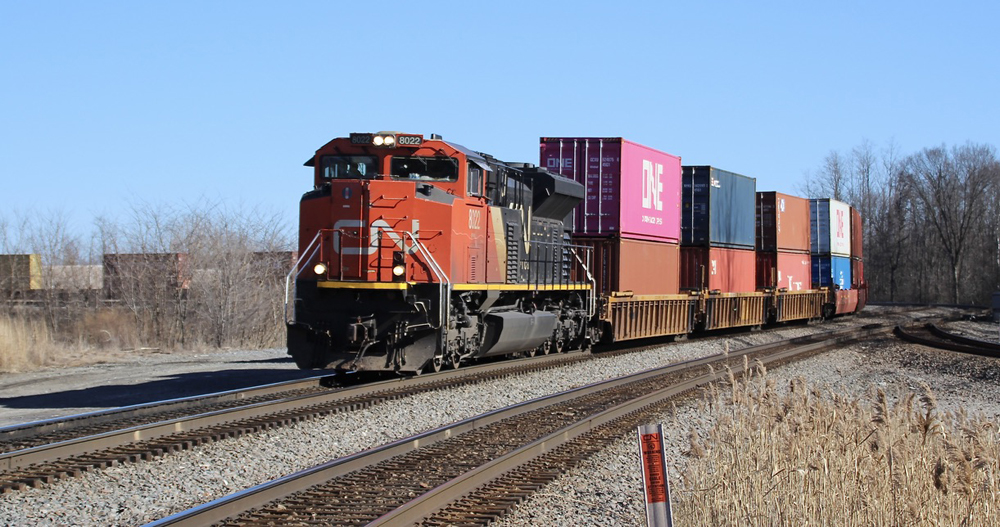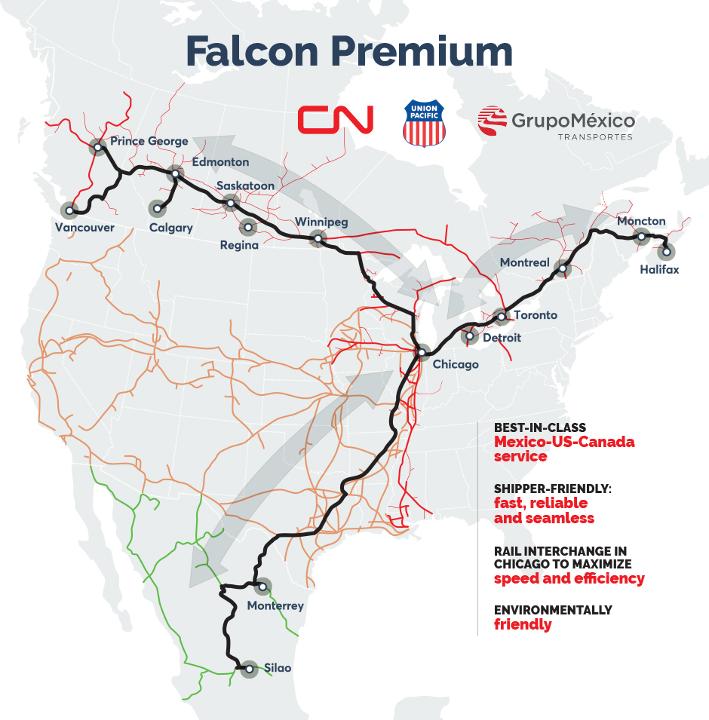
MONTREAL — Canadian National, Union Pacific, and Ferromex will launch new intermodal service next month linking Canada and Detroit with Mexico, the railroads announced today (Monday, April 24).
The Falcon Premium service will connect a dozen CN terminals with the Ferromex terminals in Monterrey and Silao via the Eagle Pass, Texas, gateway. CN and UP will use steel-wheel interchange to exchange the traffic in Chicago via CN’s former Elgin, Joliet & Eastern Chicago bypass route.
“CN will now have the shortest route and fastest service to all of its key markets. Layering this new service with our new EMP product with the UP and NS, CN’s customers will have new options to convert truck volumes to rail,” Doug MacDonald, CN’s chief marketing officer, told investors and analysts on the railway’s earnings call on Monday.
CN will essentially be tying its intermodal network to existing Chicago-Mexico service that UP and Ferromex currently offer. The Falcon service will be six to eight days faster than current CN routing options to Mexico, MacDonald says.
Falcon Premium’s transit times from Monterrey to Toronto will be eight days from cutoff to availability, according to schedules posted on the UP website.

MacDonald says UP and Ferromex provide the best intermodal service offering between Chicago and Mexico. “It’s been phenomenal,” he says. “The customers rave about it.”
CN believes there are two trains’ worth of volume moving in each direction every day via truck, based on market research conducted as part of its ill-fated attempt to acquire Kansas City Southern. “We’re targeting that business,” MacDonald says.
The potential traffic includes automotive parts, food, freight all kinds, home appliances, and temperature-controlled products, the railroads said.
In October, CN became a full partner in the UP-Norfolk Southern EMP container pool, which MacDonald says will benefit the Falcon Premium service by providing equipment that intermodal marketing companies can use.
UP in October booted Canadian Pacific out of the EMP program in advance of the CP-KCS merger. Last week CPKC landed a multi-year contract to handle Schneider National’s intermodal traffic between the U.S. and Mexico [see “CPKC to handle Schnider’s cross-border intermodal shipments …,” Trains News Wire, April 21, 2023]. Schneider’s Chicago-Mexico traffic currently moves via UP.
Asked how Falcon Premium would match up with CPKC’s single-line service, CN said it believes it will have the best intermodal service between Canada, Detroit, and Mexico. “It doesn’t matter what my competition does. We have a great product with this. And we think we’re actually going to have the fastest service,” MacDonald says.
The chief executives of all three railroads praised their deal.
“Falcon Premium service is a game changer for intermodal customers,” CN CEO Tracy Robinson says. “By leveraging each partner’s best services and routes, we are creating a transformational new product. Our commitment is to run this service with the utmost focus to maximize speed, reliability, and customer satisfaction. This service is an example of how collaboration and cooperation can improve supply chains for customers.”
UP CEO Lance Fritz says the service will take advantage of the shortest route between Chicago and Mexico. “We are excited to be a part of this new intermodal service connection, which leverages our unmatched route into and out of Mexico and strengthens our intermodal service portfolio,” he said in a statement.
Fernando Lopez, CEO of Ferromex owner Grupo Mexico, said, “The Falcon Premium service is tailor-made with the objective of providing new solutions to customers catering to the requirements of nearshoring demands.”














What CPKC can do, CN/UP can do one better, any way you want it!
I think CP had to acquire KCS, before someone else did. “Grow or Die.”
CP has a $31b purchase price to digest, plus major plant expenditures to handle any traffic growth. It is between a Rock [spend money] and a Hard Place [save money].
Mark Meyer is correct.
Here’s how it’s probably going to play out.
After a few weeks of operations, CN likely will add two or three blocks of mixed traffic to lengthen the train up to 12000′, and weight it up to 15000 tons because, you know, #PSR.
Some of this traffic will be speed-restricted, so trains cannot run faster than 50mph (35mph in urban areas), and several stops en route will be added to pick up or set off these mixed blocks, adding at a day to an already-slow schedule.
Of course, CN will only assign two units (~0.6hp per ton) because that’s what it usually does. So it may not even reach 35mph. Add another half-a-day, and plan some recrews enroute because trains will not reach their terminal before the HoS law kicks in.
After a few months of operation, the train will be cut back to 5 days a week to make up for loss of volumes, and a few months later to 3 days a week for the same reason.
After less than a year, service will be droped completely, citing lack of customer interest (for a slow and unreliable service more suited to CN’s obsession with cost-cutting rather than truly satisfying the customer).
For past reference: see intermodal service on St.Lawrence & Atlantic to Auburn, ME, CN intermodal service to Jonquières, QC (twice), direct Halifax – Chicago service (122-123 dropped earlier this year after a few months of operation), former intermodal service to old IC facilities in East St.Louis and Council Bluffs, former New England Clipper service with Guilford (Halifax to Boston), the roadrailers of the early 2000’s, and so on.
Make no mistake: Marketing may be willing to grow their traffic, but Operations will make sure it doesn’t happen.
The Falcon flies again.
Here are some explanations from someone with real Mexican rail experience. First, never forget UP owns about 20 percent of Ferromex.
Second one of UP’s and Ferromex’s largest customers is the brewery at Piedras Negras which ships beer in boxcars primarily to the Constellation Brands warehouse in Northlake about half a mile from the hump tower at Provide. UP has a pre-trip facility for the boxcars in Eagle Pass. Great moves for UP; one time they did everything right here.
Also don’t forget about the home appliances in the Monterrey-Saltillo area (Whirlpool and Koreans). Perfect boxcar business, heavy and very bulky. Not enough trailers and containers in North America to handle all this business, which is why high cube boxcars ae the perfect fit.
So, about half the potential intermodal tonnage is already moving in boxcars which are the better fit logistically. Long term about 75-25 split boxcars to containers. Not much real-world potential here.
Also, El Paso is the second busiest crossing on the southern border and UP is building a marvelous yard at Santa Theresa. Why not two dedicated intermodal trains one out of each border crossing and then do some block swapping and build two dedicated daily trains for different eastern destinations?
Union Pacific has the better franchise and definitely the better routes to and through Chicago, with CN.
The things UP did right were before Lance Fritz and his accounting cronies and background became CEO. Before then, every UP Chairman had railroad operations experience or had worked within UP operations. That about describes the difference between UP then and UP now. Only a true railroad man who can give up on the bad ideas of PST can do what Lance Fritz could not do: Make the railroad safer and serve ALL the customers like they used to.
Makes you wonder if the Class 1’s saw Wall Street as a bigger customer than those actually using the railroad…
“Falcons” were the premium CNW i/m trains between Chicago and Fremont.
I can’t Stop Laughing about The Way UP Ferromex and Canadian National just can’t leave well enough alone and What is it going to Prove in Chicago if It Gets Congested and Trains are Backlogged
Well (as the article states), the actual interchange will likely be in Joliet via the former EJ&E (now CN) which bypasses Chicago proper. The (northbound) trains would come from the south into Joliet, and head east on the ex-EJ&E to Griffith, Indiana and onto the ex-GTW for Detroit, Toronto and Montreal. This is in contrast to the CPKC trains which would enter the Chicago complex from the northwest (a testimony to the route’s circuity) and likely use the IHB/BRC get to the Southeast part of the metro area to reach NS track which it uses to get to Detroit. I can’t believe that there will be any dedicated trains from Mexico to points in Western Canada, such as Winnipeg or west, but if there are, UP could send those on a straight shot from Texas via Fort Worth, McAlester, Kansas City, Des Moines, St. Paul to interchange to CN at Saunders, WI (Pokegama Yard). Any way you slice it, CPKC’s routes suck horribly out of Mexico compared to the competition and no amount of touting their “single line” service can overcome the superiority of (in mileage and profile) of UP and BNSF routes. And while UP/CN have better routes to avoid Chicago, KCS is stuck having to go through Houston using UP. And through the whole merger process, KCS always claimed that while they were going to spend millions and millions of dollars to upgrade their track on the primary route out of Mexico, the Houston terminal operated by UP was just fine and could accommodate any increase in traffic even though UP said this wasn’t the case. So, I guess should UP mistakenly (as in not deliberately, only maybe on purpose by accident) delay once of CPKC’s new hotshot trains from Lazaro Cardenas to Saint John in the Houston terminal, they really can’t complain too much about it…..
Wonder if NS wishes it still had the long abandoned Joliet branch, which ran from Joliet to what is now Lake Station Indiana and connected to the former NYC?
Maybe all the CP…errrr,,,CPKC fans should quit defending the CPKC single line route as the move of all moves and consider what the competition just did to them.
CP had to do something to justify purchasing (merger, right!) KCS. For them, as Mark Meyer has pointed out, it is a circuitous proposition that, yes, does involve single line movement but must move over foreign roads that are not going to put CPKC trains ahead of their own, as KCS has known for years.
So what have they accomplished? Well they stole the headlines from CN for a a few months and ended up with the same thing they already had, paying 31 billion for the privilege. Most of Canada’s Intermodal is going west to the ports in BC. Except for the new Schneider MIDWEST traffic to Mexico via UP in Houston and every other gateway to Mexico (or BNSF as opportunity arises…) They will still have to use UP to get where they want to go, unless they plan on building a new gateway to the Mexican ports which do not exist today. That could cost a hundred billion and neither railroad that makes up CPKC has the cash to do it or loan it even if they think they could.
This could go down in history as a big mistake on the part of Keith Creel at CP… a big mistake.
I wonder why they’re crossing the border at Eagle Pass instead of Laredo. This routing traverses the ex-S.P. mainline that already appears to be clogged, based upon U.P.’s freight train interference delays to Amtrak’s “Sunset Limited.” And what’s gonna happen when Amtrak tries to take the “Sunset” daily? And why are they routing through busy Houston when they have at least two optional routes that bypass Houston, ex-Cotton Belt via Corsicana and ex-MoPac via Palestine?
At this point, I think the UP is trying to make Amtrak’s operations of their trains, if not other railroads operations of trains on UP lines as much of a living nightmare as they can. Historically, UP in many ways, was kind of like the bully character, and they kinda still are the bully and mainly care about themselves, not others. I mean, they have a policy where only their own steam locomotives can do excursions on UP tracks, so SP 4449 and 2472, as well as Cotton Belt 819 can’t even run on their home rails because of the UP, unless something along the lines of what happened in 2007 with UP 844 and SP 4449 occurs.
The border crossing is at Eagle Pass/Piedras Negras (instead of Laredo/Nuevo Laredo) because the interchange is between UP and Ferromex. At Laredo/Nuevo Laredo, the UP (and KCS) interchange is with CPKC (Kansas City Southern of Mexico). And the routing (according to the map) is via Palestine, not Houston.
Mark Meyer, looking at the map again, you are correct that the routing will bypass Houston. But it’s hard to tell, due to lack of map detail, whether the routing southwest from Texarkana is ex-Cotton Belt or ex-Mopac.
Jeffrey: With regard to your inquiry, the route depends on which way the train is going. The Cotton Belt/SP route is usually for southward trains, with the ex-MP (and T&P) being northward trains. This is true from both Houston and San Antonio. Yes, it’s hard to tell exactly what’s what from the map because there are so many route options and that’s just another of the weaknesses of CPKC. While UP has four main line routes north out of Texas, CPKC has but one, and it’s not great.
Harrison, SP 4449 and 2472, and Cotton Belt 819 are not owned by UP but by private individuals or foundations. All they have to do to run on the UP is to buy the required insurance that all railroads require of private entities to use UP track. UP’s Heritage Steam Program has Priority because it is a UP Corporation entity. Every time someone has asked that UP Steam Engines visit their locale, they have had to buy the insurance for the steam engines once of UP rails. That is no different than BNSF, CSX or NS for that matter. Not sure how CPKC will do it.
It’s not being a bully, its a smart business plan to cover the costs of any incident that could happen and turn into millions of dollars!
Sounds like a kneejerk reaction to the CPKC merger. I wonder if they’re testing the waters for a three-way merger?
Given how an analysis after the STB rejected the CN-KCS merger says that pretty much any class 1 merger at this point is probably DOA, unless they create a separate railroad to control these parts of their tracks, or in one way or another a short line railroad buys out all of these tracks that they own and become a new Class 1, I doubt that a 3 way merger is going to occur. But I could be wrong. I haven’t lived long enough to determine what can or can’t happen, I’m a college student who will turn 20 next year while the rest of you guys are probably Gen X and baby boomers. Also I’m probably a little bit too optimistic about things.
Nope. The kneejerk was the CP-KCS merger in the first place. I think this announcement from UP and CN is just a dig at CPKC to remind them that if you have worst route from the Upper Midwest and Chicago to Kansas City, and the worst route from Kansas City to the Mexican border, you still have the worst route, even if it’s now one railroad instead of more than one.
Prophetic or careless map-making? The Falcon map shows connecting shortlines in Nova Scotia that have been dormant for a decade.